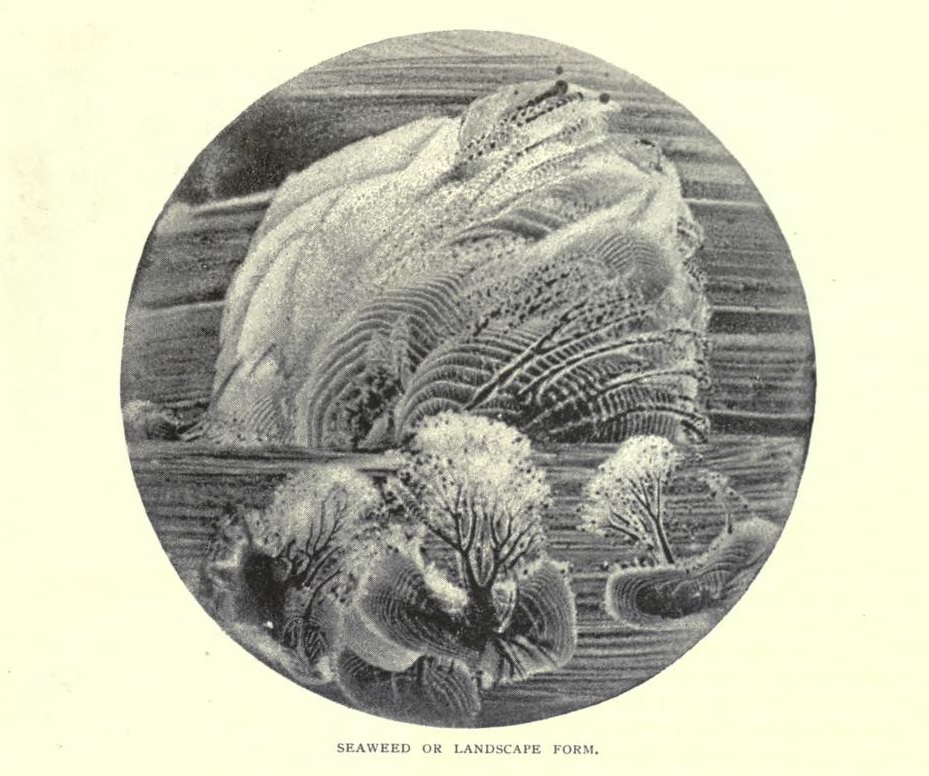
Voice-Figures
2014 March 10

Women, it goes without saying, were not much encouraged by the Nineteenth Century scientific Establishment. Nevertheless, there was gradual progress -- this was, after all, the Century of Progress -- and in 1876 the Royal Society's "Soirée Committee" created a new programme of conversazioni -- informal presentations of scientific research, with music and refreshments -- which women were free to attend, and where they could even present their own work. One of the first to do the latter was not a professional scientist at all, but a well-known soprano and voice teacher, Mrs. Margaret Watts Hughes. Her subject-matter, of course, was predictably feminine: music and flowers ! Well ... in a way. Here is how she described her research to a popular audience a few years later:
VISIBLE SOUND -- VOICE-FIGURES
by Margaret Watts Hughes
[Century Magazine 42, 37 (1891)]
Hughes's words are in bold.
The peculiar forms shown in the illustrations of this article, and which I call Voice-Figures, have excited much interest since their recent discovery,when exhibited in London, England, at the rooms of the Musical Association, the Royal Institution, The Royal Society, and elsewhere.
In 1885, while seeking means to indicate readily the intensities of vocal sounds, I first met with these figures, and, owing to their variety both in form and production, they have since absorbed much of my attention. The apparatus I have employed I call the eidophone. This is very simple. It consists merely of an elastic membrane, such as thoroughly flexible soft sheet-rubber, tightly stretched over the mouth of a receiver of any form, into which receiver the voice is introduced by a wide-mouthed tube of convenient shape. In some cases the receiver may be dispensed with, and the membrane be stretched across the open end of the tube itself.
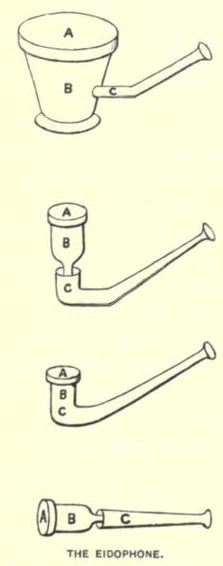
The accompanying sketch shows different forms of this instrument that I have found convenient for various classes of voice-figures. In all forms of the eidophone here shown the disks are circular, but of course other forms may be used.
My first experiments were made with sand, lycopodium powder, or the two substances mixed. I then tried for the production of voice-figures, flooding the disk of the eidophone with a thin layer of liquid ; e.g. water or milk. Upon singing notes of suitable pitch through the tube, not too forcibly, beautiful crispations appear upon the surface of the liquid, which vary with every change of tone. A note sung too forcibly causes the liquid to rise in, a shower of spray, the movements of which are too rapid to be readily followed by the eye. To facilitate observation denser liquids may be used. By using such liquids as colored glycerin particularly beautiful effects may be obtained. Subsequently I found that by employing moistened powder of different consistencies yet another description of figures appears. The earliest result of my experiments in this material shows centers of motion from which radiations diverge.
But while engaged one day in producing this class of figures I observed that exactly in the middle of each of the motion-centers there was a tiny shape like a forget-me-not flower !
In the course of various attempts to isolate these diminutive forms I discovered that by placing upon the disk only a very small quantity of the wet color-paste, and then singing different sustained notes, a number of little figures made their appearance in turn.
My next efforts were to see how the voice would deal with such moist color-paste in larger quantity, and these resulted in the production of the larger-sized floral forms shown in the illustration :
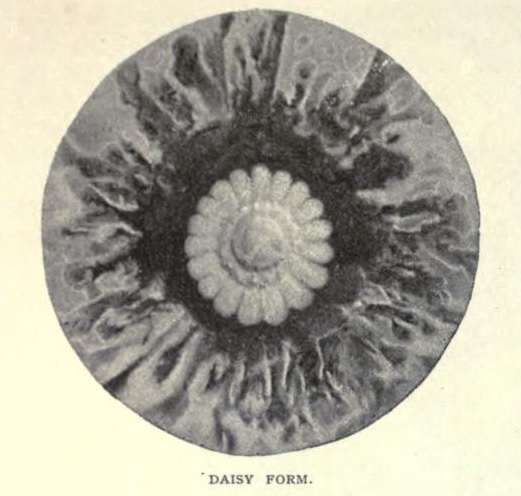
At this stage I was first able to observe clearly the remarkable behavior of these voice-flowers at the instant when they spring into shape, and it seems to me quite as worthy of notice as the forms themselves. Let me endeavor to describe it briefly.
With the wet mass lying in the center of the disk, a sustained note must be sung very steadily, having been begun with a moderated intensity. The first effect is that the color-paste gathers itself more and more closely into a heap in the very center of the disk. Singing on, and carefully maintaining an unvaried pitch, I find the next effect to be that the little heap begins to agitate itself about its edges. Now is the moment to increase the intensity of the note, still steady in pitch; suddenly all around the heap petals shoot out like those of a daisy from the raised center, also very like that of the real flower.
Perhaps it may happen possibly from the condition of the color-paste that the first display of petals comes out imperfect. If so, then all that is needed is just to sing the same note again, but diminuendo, and straightway all the petals will retreat into the central heap, as at first. Then the singer may try once more, and another crescendo will probably achieve the production of a perfect floral form.
This description of voice-figure I have called the "daisy" class, but it includes varieties that resemble rather the marigold, the chrysanthemum, and the sunflower.
The special feature of this daisy class is a ring or rings of petals, generally pretty even in size, surrounding a raised center. The number of petals may be from six to thirty or more, for the number increases with every rise in the pitch of the note sung. They usually appear as a single layer around the center, but I have at times noticed two, three, or four layers of petals partly overlapping each other, showing the same difference we see between our double and treble garden-flowers and their simple wild progenitors.
The centers of these daisy forms will also be found worth examination. I have often observed them rising in two, three, or more tiers either of circular or starlike shape, with sometimes the topmost tier crowned with a cross. Round the base of the center I have frequently noticed, too, a complete ring of raised dots, equidistant from one another, and each of which is itself probably a tiny center of motion. I regret particularly that I have not found it possible to preserve perfectly the most delicate of these floral forms, as they in part collapse when the moist paste dries.
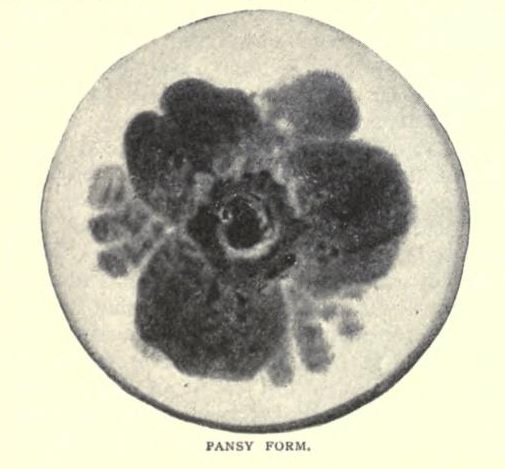
Further, I may mention that I have also obtained another description of voice-flowers, distinct from the above-mentioned daisy class both in form and in the manner of its production, which may be called a "pansy" class, with varieties more like the violet, primrose, or geranium.
To obtain these pansy forms, about the same quantity of color-paste as for daisy forms must be placed upon the disk, but with considerably more water, sufficient water being required to allow the paste to move freely on it when disturbed by the vibrations of the elastic disk, the petals seeming to shoot out from the centers of motion and then to spread themselves in the water. This class of flower forms usually has its petals in threes, whether one, two, or more sets.
In leaving the floral forms I may mention that great care and delicacy in singing are demanded for their production, which will afford ample training for any vocalist in regard to the steady sustaining of notes in intensities from the softest pianissimo to a very loud forte, as every grade of intensity is required in its turn in order to evoke these forms in their various sizes, ranging from that of a pinhead to that of a large-sized daisy.
Here, too, I may say that when notes have been sung with special force, I have sometimes observed, along with the figures usually appertaining to those notes, certain additional curves and forms presenting themselves, and I am convinced that these latter belong to overtones actually produced at the same time, but inaudible even to a well-trained ear. If correct, this illustrates the extreme sensitiveness of the eidophone as a test for musical sounds, detecting and revealing to the eye, as in these cases, what the ear fails to perceive.
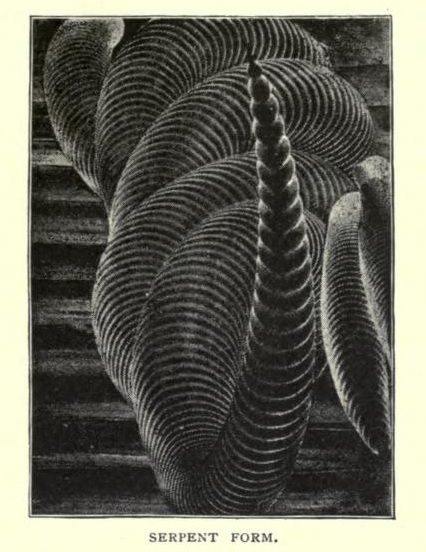
We now pass to a large class of voice-figures quite distinct from all that we have so far noticed ; viz. figures obtained upon plates of glass or other smooth surfaces brought into contact with the vibrating disk, both plate and disk having been coated with liquid color.
In this class of figures I have been much gratified by obtaining very delicate yet perfectly clear wave-line impressions that constitute an actual and permanent record of every individual vibration caused by the voice, each tiny undulation of the surface of the disk standing registered with strict accuracy and with a beautiful minuteness that rivals the lines of a well-executed engraving.
The figures would be circular if they were taken directly from the disk. The spiral or serpent form in which most of these impressions have been taken is chosen mainly for the purpose of bringing within the boundaries of the plate a greater length of figure than an impression taken in any straight direction would have included. The remarkable perspective effects shown in most of these spiral figures are, however, deserving of notice.
It may perhaps be worth pointing out, too, that in the case of these spiral forms the rule that the higher the pitch the greater the number of vibrations indicated is modified by the direction in which the plate, or disk, or both, may be moving during their contact, and the rapidity of the motion.
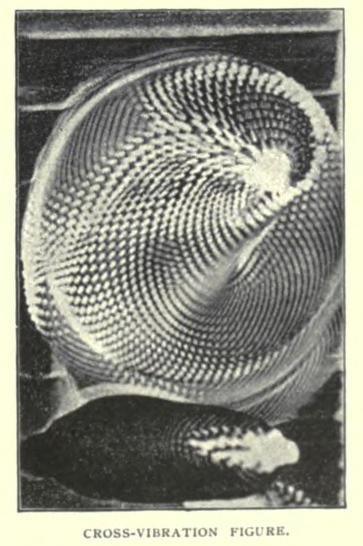
These mere wave-line impressions are, I think, the simplest of all voice-figures, and next in simplicity come what I may call cross-vibration figures, which speak for themselves in the illustration.
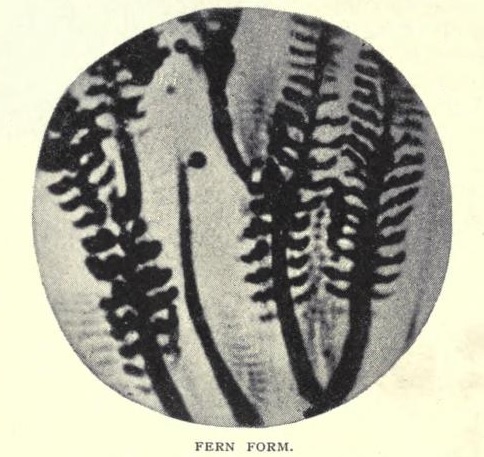
Both the comparatively simple kinds of figures just mentioned are obtained by using only a very slight coating of color, and that so wet as to occasion little or no adhesion between the plate, the color, and the disk. We may, however, alter the conditions by employing a larger quantity of color-paste. This at once complicates the matter by introducing adhesion of considerable force between the coated disk and the coated plate, which, when laid upon it, adheres firmly, and, accordingly, adhesive attraction combines with the vocal impulses in forming such figures. Shall we call this a "fern" form ? To produce this it is essential to sing a peculiar and powerful note at the precise moment that the plate and the disk, which had adhered together, are separated.
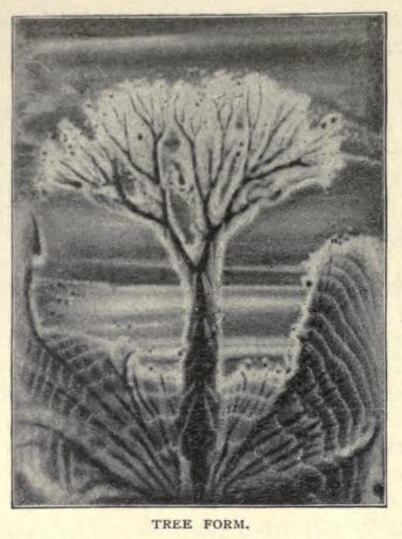
The last class of voice-figures to be mentioned here are also plate-impressions, and some of them are shown in all the specimens of this class, along with a somewhat curious resemblance to miniature landscape pictures. I think an observer cannot fail to notice one or more figures that will justify their designation as "tree" forms.
Closing now my brief sketch of these voice-figures as I have observed them, I would add that my experiments have been made as a vocalist, using my own voice as the instrument of investigation, and I must leave it for others more acquainted with natural science to adjust the accordance of these appearances with facts and laws already known. Yet, passing from one stage to another of these inquiries, question after question has presented itself to me, until I have continually felt myself standing before mystery, in great part hidden, although some glimpses seem revealed. And I must say, besides, that as day by day I have gone on singing into shape these peculiar forms, and, stepping out of doors, have seen their parallels living in the flowers, ferns, and trees around me ; and, again, as I have watched the little heaps in the formation of the floral figures gather themselves up and then shoot out their petals, just as a flower springs from the swollen bud, the hope has come to me that these humble experiments may afford some suggestions in regard to nature's production of her own beautiful forms, and may thereby aid, in some slight degree, the revelation of yet another link in the great chain of the organized universe that, we are told in Holy Writ, took its shape at the voice of God.
Margaret Watts Hughes.
In the middle decades of the Twentieth Century, Hughes's flower-like forms were independently rediscovered by the Swiss researcher Hans Jenny, as seen in the following 2-minute excerpt from a 1960s documentary (© 2010 MACROmedia Publishing // Cymatic Source):
But let us return to the Nineteenth Century. Margaret Watts Hughes believed (and correctly so) that her findings were astonishing, and that revolutionary developments in theoretical physics would be required to explain them. However, theorists often see in data what they expect to see. In the next episode of this series (to be posted in four weeks), a professional Nineteenth Century scientist -- also a woman, as it happens -- will provide a (very good) popular summary of the physics of standing-wave resonance, and suggest from this that Hughes has merely observed an interesting and complex special case. That will lead us in the third episode backward to Ernst Chladni, and in the conclusion forward to the dawn of chaos theory.
"Una donna a quindici anni"
from Mozart's Così fan tutte (1790), sung
into a Jenny
tonoscope by Jennifer Baron. The geometrical patterns visible here,
while intriguing, are more obviously related to
the classical theory of standing waves than are the complicated
"organic" designs created by Margaret Hughes.
SINGING IN CHLADNI'S GARDEN